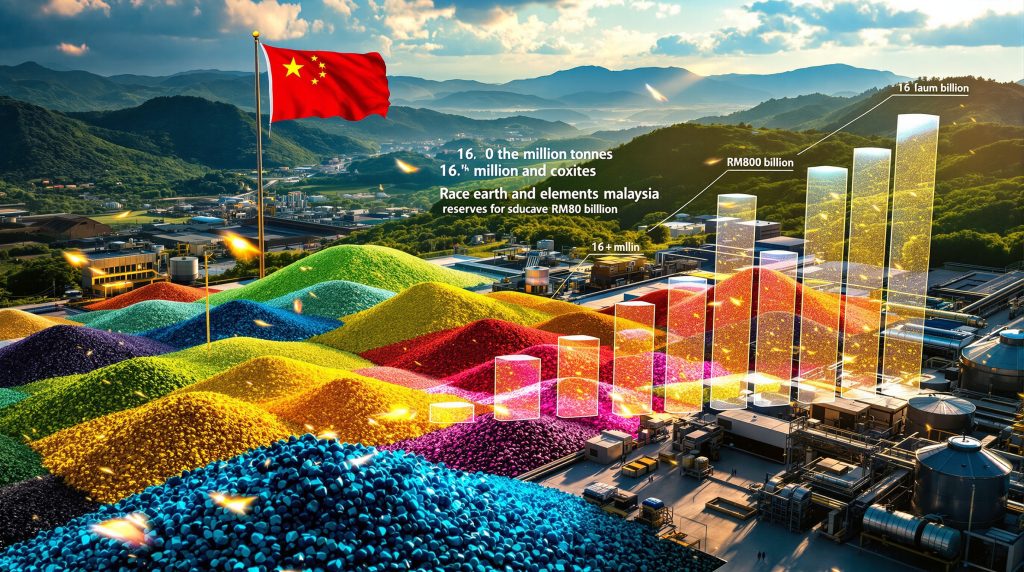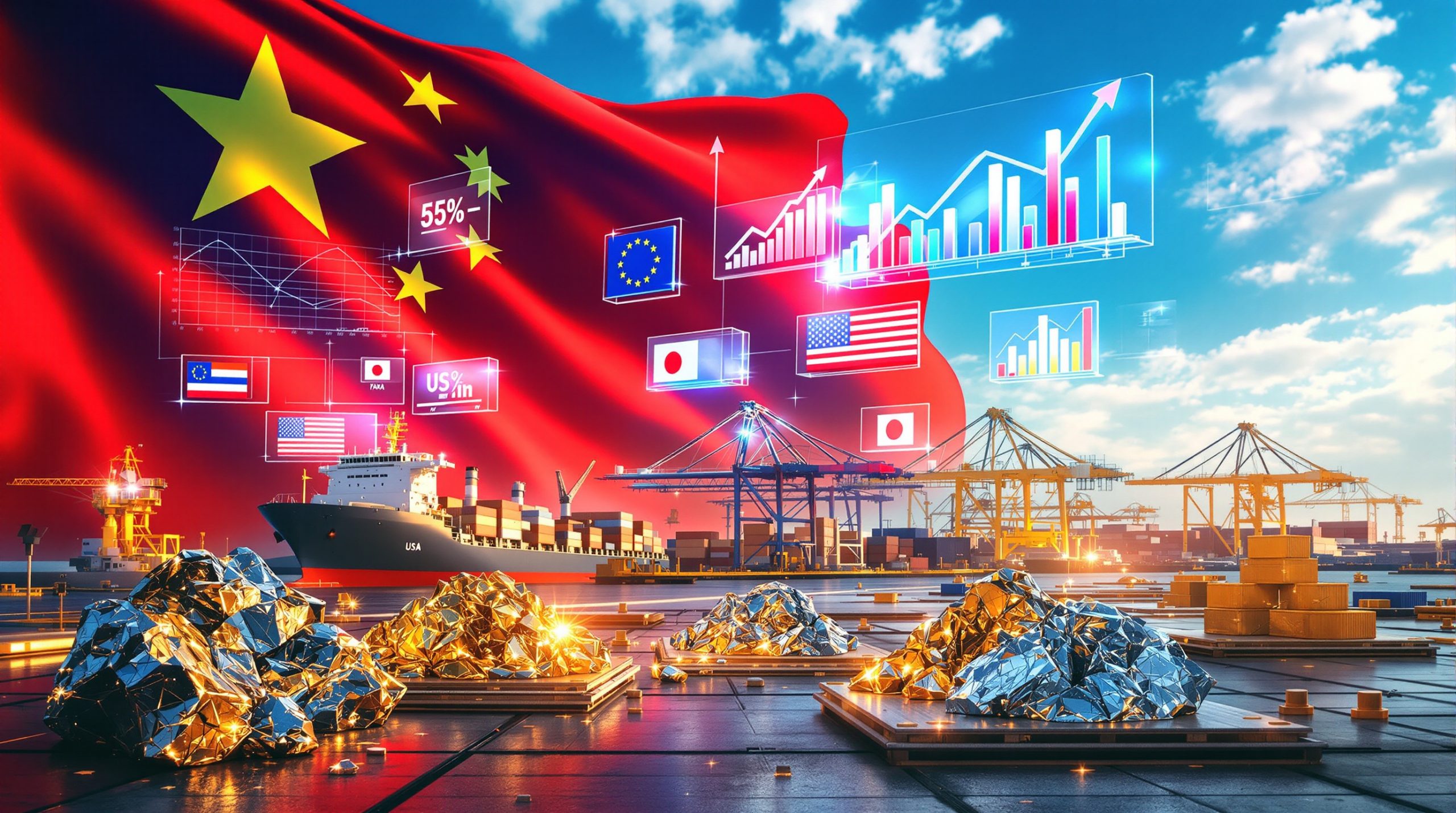Malaysia's strategic alignment with China on rare earth processing emerges from national ambitions to elevate its place in the global critical minerals supply chain. This Malaysia rare earth processing partnership with China represents a calculated move to transform the country from a raw material exporter to a value-added manufacturing hub. Recognised as Southeast Asia's most promising rare earth prospect, Malaysia possesses an estimated 16.1 million tonnes of non-radioactive rare earth elements (REE), valued at about RM810 billion.
Rather than rely on the traditional model of exporting unprocessed concentrates, Malaysia is shifting toward midstream and downstream activities. Historically, unprocessed rare earth oxides fetch several hundreds of dollars per tonne, while processed oxides—used in magnets, electronics, and green technologies—command prices in the thousands per tonne. This enormous value differential forms the economic backbone of Malaysia's high-stakes pivot, particularly as surging critical minerals demand transforms global markets.
China, holding over 80% of global rare earth refining and processing capacity, brings decades of technical mastery and industrial scale. Malaysia's partnership, then, is a calculated trade: unlocking advanced Chinese know-how in exchange for access to its vast, untapped reserves. The ultimate prize is twofold: Malaysia accelerates economic diversification, and China shores up its resource base amid rising global competition for electromobility and clean energy minerals.
The Economic Imperative Behind Processing
Malaysia's focus on value capture is rooted in these realities:
- Processed REE materials can multiply export revenue by an order of magnitude
- Establishing refining plants stimulates domestic job creation in high-skill engineering, science, and technology sectors
- The move positions Malaysia as a critical supplier not just within ASEAN, but to global industries dependent on permanent magnets and advanced electronics
Furthermore, this approach aligns with broader mineral beneficiation insights that demonstrate how countries can maximise value from their natural resources through downstream processing.
Malaysia's transformation strategy signals to both local and foreign investors that the country seeks to become a formidable midstream player, fundamentally altering its supply chain role.
What Does Malaysia's Rare Earth Processing Partnership with China Include?
Technology Transfer Framework
Early-stage dialogue highlights a technology-for-resource exchange: Malaysia offers access to its REE reserves, while Chinese state-owned enterprises deploy proprietary separation and purification technologies. This exchange is consistent with patterns observed throughout China's global critical minerals strategy, aimed at securing raw materials whilst protecting core process knowledge.
Chinese separation technology utilises sophisticated solvent extraction and ion exchange methods that rival Western systems in throughput and purity. Malaysia expects to acquire these advanced techniques, enabling local refineries to match international quality benchmarks and environmental standards. However, the partnership is structured tightly around government-linked entities, ensuring that technology transfer remains controlled.
Infrastructure Development Plans
Malaysia and China envisage a joint approach that leverages complementary strengths. The proposed structure, reported in industry sources and validated by on-the-ground accounts, resembles:
| Component | Malaysia Contribution | China Contribution |
|---|---|---|
| Raw Materials | 16.1 million tonnes REE | Processing technology |
| Infrastructure | Land, regulatory framework | Equipment, engineering |
| Workforce | Local employment | Technical training |
| Market Access | ASEAN and global linkages | Global distribution networks |
Significantly, involvement centres on Khazanah Nasional, Malaysia's sovereign wealth fund, and a yet-unnamed Chinese state-owned enterprise. Khazanah's managing director, Datuk Amirul Feisal Wan Zahir, has stressed that at this stage, discussions focus on exploration and policy alignment—no formal capital deployment has commenced.
Investment Structure Considerations
This government-to-government negotiation framework underscores the strategic seriousness both capitals attach. Substantial investment is anticipated, including land allocation, facility construction, upstream mining investments, and extensive skill development. As with similar international mineral projects, joint venture equity splits, technology access terms, and governance arrangements remain under negotiation.
How Does This Partnership Fit Malaysia's Broader Resource Strategy?
Domestic Processing Mandate
In August 2025, Malaysia instituted a ban on exporting unprocessed rare earth materials, requiring all REEs to be processed domestically before being sold abroad. This policy, aligned closely with initiatives in countries like Indonesia for nickel and bauxite, aims to keep more value onshore and stimulate local manufacturing of magnets and advanced components. The law marks a significant pivot away from the country's prior role as a raw exporter.
Multi-Partner Approach
Malaysia is not putting all its eggs in the China basket. The nation recently signed an agreement with the United States for technical and commercial REE collaboration, forming a strategic rare earth partnership that demonstrates its multilateral approach. Additionally, it maintains ongoing ties with Australia's Lynas Rare Earths, the world's leading non-Chinese processor.
In July, Lynas agreed with South Korea's JS Link to manufacture up to 3,000 tonnes of neodymium-iron-boron magnets per year in Pahang, Malaysia. This development reflects broader trends in the mining industry evolution towards strategic partnerships and technological advancement.
Prime Minister Anwar Ibrahim clarified that Malaysia's U.S. trade pact does not restrict rare earth supply to American entities only, underscoring a balanced, multilateral approach.
Regional Hub Ambitions
Combining strong infrastructure, deepwater ports, and political stability, Malaysia seeks to become the principal processing and distribution platform for ASEAN's rare earths. Its proximity to regional mines, skilled labour, and established frameworks with both Western and Chinese stakeholders make it uniquely placed to moderate between geopolitical interests and maximise supply chain advantages.
What Are the Key Challenges Facing This Partnership?
Technical and Operational Hurdles
-
Resource Quality and Volume: While 16.1 million tonnes of reserves are quoted, commercial viability depends on geological consistency, grade, and ease of extraction. Not all deposits are equally valuable; quality control will determine economic outcomes.
-
Environmental Oversight: Rare earth processing often produces radioactive byproducts such as thorium or uranium traces. Malaysia's historical experience—even as far back as the 1980s—demonstrates that insufficient controls can provoke community backlash and regulatory scrutiny.
-
Technology Transfer Limits: China restricts core technology sharing to state-linked joint ventures, guarding its competitive edge. Malaysia must strike a careful balance, ensuring sufficient transfer to build capacity without ceding strategic autonomy.
Regulatory and Political Considerations
Negotiating regulatory approvals, especially in environmental domains, will be both time-consuming and crucial. Malaysia must also honour its multilateral pacts—with the U.S., South Korea, and others—whilst avoiding exclusive alignment with Beijing's interests. Achieving this balance requires transparent legal frameworks and proactive diplomatic engagement, particularly as the critical raw materials transition accelerates globally.
How Does China Benefit from This Rare Earth Processing Partnership?
Strategic Resource Access
China's primary incentive is long-term access to Southeast Asian rare earths. Whilst it dominates refinery output, growing domestic demand and mounting Western supply chain diversification have made securing non-Chinese REE resources a priority.
Regional Influence Expansion
By anchoring a rare earth plant in Malaysia, China extends its supply chain influence across the ASEAN region, reinforcing its leadership not just in processing, but also in technology and project financing. This aligns with broader Belt and Road ambitions and complements China's strategic partnerships across Southeast Asia.
Technology Leverage
China's structure—exchanging process know-how for resource access—allows it to diversify material inputs whilst keeping critical technical mastery within its ecosystem. This ensures downstream industries, especially in electronics and automotive, remain supplied and cost-competitive.
What Impact Could This Partnership Have on Global Rare Earth Markets?
Supply Chain Diversification
Malaysia's emergence as a rare earth processor offers a potential alternative to China-only supply routes, appealing to companies and nations eager for diversified, more secure sources. However, because the Malaysia rare earth processing partnership with China involves a Chinese SOE, some critics argue this "diversification" may be more cosmetic than real in the short term.
Pricing Dynamics
Additional Malaysian processing capacity could potentially stabilise global prices, especially for key inputs like neodymium-praseodymium (NdPr) oxide and separated heavy rare earths. Stable supply from Malaysia might mitigate price spikes linked to Chinese regulatory actions or export restrictions.
- Increased processing may lead to a more liquid, competitive market
- However, industry experience shows that any new plant typically needs 3-5 years from ground-breaking to commercial output—delaying near-term impacts
Geopolitical Implications
China's continued leadership in refining capacity, buttressed by partnerships like this, signals to Western governments that supply chain independence remains a long-term challenge. The complex interdependencies—technology, resources, end markets—mean truly independent supply routes are difficult and costly to establish.
Western strategies for rare earth independence must adjust to the reality of Chinese technological mediation, even in supply chains located outside mainland China.
What Are the Timeline and Next Steps for Implementation?
Current Development Status
Discussions between Khazanah Nasional and Chinese state representatives remain exploratory. No formal agreements on site location, capital commitments, or plant design have been disclosed as of November 2025. Malaysian authorities continue due diligence on both geological and market feasibility.
Critical Milestones
The path from concept to production involves several stages:
- Feasibility Assessment: Comprehensive verification of REE deposit quality, commercial extraction viability, and security of supply
- Environmental Impact Analysis: Detailed assessments, community consultations, and regulatory approval processes—especially for radioactive waste management
- Regulatory Framework Finalisation: Crafting clear rules on processing standards, licensing, technology transfer, and export controls
- Site Selection and Preparation: Identifying optimal sites, factoring in infrastructure, logistics, and environmental sensitivity
- Construction and Commissioning: Building, equipping, and staffing the facility to international standards
Industry benchmarks suggest:
| Step | Estimated Timeline |
|---|---|
| Feasibility & Environmental Study | 12-18 months |
| Regulatory/Policy Development | 12-24 months |
| Construction to Commissioning | 18-36 months |
Consequently, the fastest conceivable schedule for commercial output is 3-5 years, assuming no significant delays.
Conclusion: Balancing Opportunity with Strategic Independence
The Malaysia rare earth processing partnership with China embodies both promise and precaution. The strategic ambition—to leapfrog from raw resource exporter to an indispensable processing and manufacturing hub—could accelerate national economic modernisation and regional influence.
Yet profound challenges must be managed. Technical hurdles, environmental stewardship, technology access, and the need to avoid geo-economic capture by a single partner demand exceptional diligence, transparency, and long-term vision. Malaysia's policy of multilateral engagement, evidenced by deals with the U.S., South Korea, and others, shows political recognition of these risks.
Furthermore, as Malaysia seeks broader partnerships to develop its rare earth sector, the nation demonstrates its commitment to maintaining strategic autonomy whilst capitalising on international expertise.
If Malaysia can balance the need for foreign technology and financing with resource sovereignty, it may offer a viable template for other mineral-rich economies seeking both prosperity and independence in a polarised global market.
Disclaimer: This article discusses ongoing negotiations and projected developments as of November 2025. Actual outcomes may differ based on regulatory shifts, market forces, and unforeseen geopolitical events. Readers should not construe the information herein as investment advice and should conduct their own due diligence before making commercial or investment decisions.
Further Exploration: To delve deeper into Malaysia's rare earth strategy and explore the evolving critical minerals landscape in Southeast Asia, consult sectoral updates and educational resources available through recognised industry research platforms.
Want to Stay Ahead of Critical Mineral Discoveries?
Discovery Alert's proprietary Discovery IQ model delivers real-time alerts on significant ASX mineral discoveries, instantly empowering subscribers to identify actionable opportunities ahead of the broader market. Understand why major mineral discoveries can lead to substantial market returns by exploring Discovery Alert's dedicated discoveries page, showcasing historic examples of exceptional outcomes.




